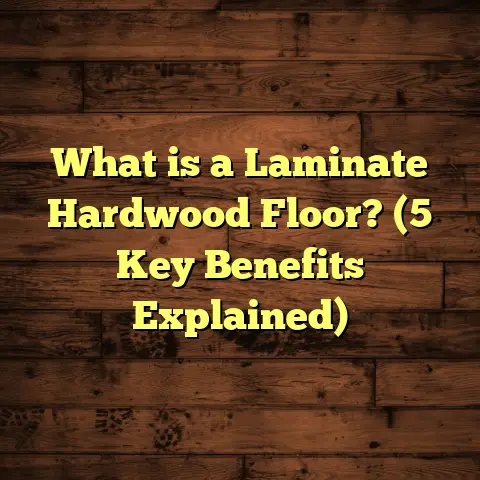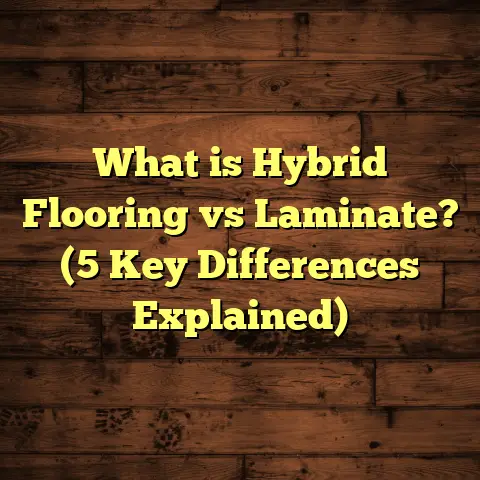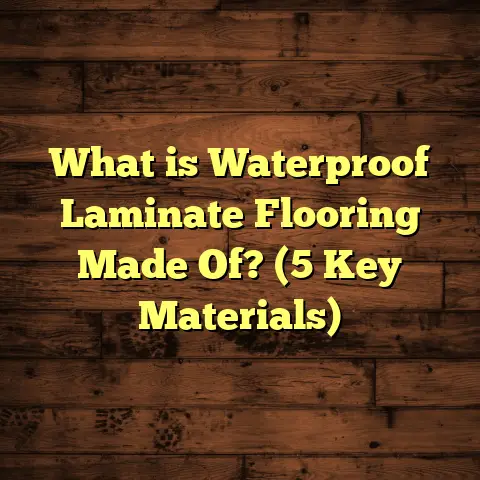What is a Terrazzo Floor? (5 Stunning Benefits Revealed)
Safety is one of the first things I think about whenever I’m working on a flooring project. Floors are the foundation of any space — they carry the weight of people, furniture, and all kinds of activity every day. If a floor isn’t safe, it can cause slips, trips, or falls that lead to injuries. That’s why I’m always searching for flooring materials that combine beauty with strength and safety. Terrazzo flooring has consistently stood out to me for these reasons and many more.
People often ask me about terrazzo floors because they see them in airports or museums and wonder what makes them special. From my years working as a flooring contractor, I’ve learned that terrazzo is much more than just eye-catching. It’s a material with an amazing history, unique installation process, and benefits that make it a top choice for both commercial and residential spaces. I want to share everything I know about terrazzo — what it is, how it’s made, the benefits I’ve seen firsthand, plus tips and stories from my work on terrazzo projects.
What Is a Terrazzo Floor?
You might have heard the term “terrazzo” before but aren’t quite sure what it means. Simply put, terrazzo is a composite flooring material made by embedding small chips of marble, quartz, granite, glass, or other aggregates into a binder such as cement or epoxy resin. After the mixture sets and hardens, the surface is ground down and polished to reveal a smooth finish with colorful chips shining through.
Terrazzo floors are known for their glossy, mosaic-like appearance and incredible durability. The name “terrazzo” actually comes from the Italian word for “terrace,” where this technique was first popularized centuries ago. The method originated in Venice during the 15th century when workers reused leftover marble chips from construction to create decorative flooring on terraces and patios.
The Terrazzo Making Process: Step by Step
Understanding how terrazzo floors are made helps explain why they look so seamless and last so long. From my experience working alongside terrazzo specialists, here’s how the process typically unfolds:
- Preparation of the Substrate: The concrete or base surface must be leveled and cleaned thoroughly to ensure proper adhesion.
- Setting Divider Strips: Metal strips (usually aluminum or brass) are placed on the floor to create sections or patterns. These strips help control cracking and allow for design customization.
- Mixing the Terrazzo: The binder (cementitious or epoxy) is mixed with the chosen aggregates like marble chips or recycled glass. The proportions depend on desired texture and color.
- Pouring and Spreading: The terrazzo mixture is poured into the sections and spread evenly with trowels.
- Curing: The floor is left to cure for several days, depending on the binder type.
- Grinding: Once cured, diamond grinders gradually grind down the surface to expose the chips and create a smooth finish.
- Polishing: The floor is polished with finer abrasives until it achieves the desired shine.
- Sealing: Finally, a sealer is applied to protect against stains and moisture penetration.
The entire process demands skill and patience but results in a floor that’s not only beautiful but built to last decades.
Different Types of Terrazzo
I’ve worked mostly with two primary types of terrazzo:
- Cementitious Terrazzo: This traditional type uses Portland cement as the binder. It’s more breathable and better suited for outdoor or high-UV environments but takes longer to cure.
- Epoxy Terrazzo: This modern version uses epoxy resin binders which cure faster and allow for more vibrant colors and thinner installations. However, it’s less UV resistant and usually used indoors.
There are also precast terrazzo tiles available for faster installation but they don’t offer the same seamless look as poured terrazzo.
My Experience Working With Terrazzo Floors
Having installed terrazzo floors in schools, hospitals, hotels, and private homes over 15 years, I’ve gathered plenty of insight on why this flooring continues to impress.
One memorable project was a local library renovation where we removed old vinyl tiles to install cementitious terrazzo with embedded river stones collected from nearby streams. The client wanted a connection to nature expressed through the floor design. The end result was stunning — visitors often commented on how welcoming and warm the library felt.
Another project involved epoxy terrazzo in a busy hospital lobby. We needed a floor that could withstand constant foot traffic, wheelchair movement, and frequent cleaning with hospital-grade disinfectants. Terrazzo’s seamless surface made cleaning easy while resisting scuffs and stains that would ruin other materials.
What really strikes me about terrazzo is its versatility — it can be tailored to fit nearly any environment or aesthetic preference without sacrificing durability or safety.
5 Stunning Benefits of Terrazzo Floors
Here are five benefits I’ve seen repeatedly in my work that make terrazzo a standout choice:
1. Durability That Lasts Generations
Terrazzo floors are incredibly durable — they can last 40-50 years or more if installed correctly and maintained properly. I’ve seen floors installed in the 1930s still going strong today.
The secret lies in terrazzo’s composition: marble and stone chips embedded in hard binders create a surface resistant to cracking, chipping, and abrasion. It withstands heavy foot traffic like no other flooring material.
Statistically speaking:
- Terrazzo floors exhibit wear resistance ratings among the highest in ASTM standards.
- They endure over 100 million foot strikes per square inch before showing significant wear.
- Compared to hardwood floors which may last 15-25 years under heavy use, terrazzo offers unmatched longevity.
One case study I recall involved a university gymnasium where epoxy terrazzo replaced worn-out rubber flooring. Even after years of intense daily use by athletes, no major repairs were necessary.
2. Simple Maintenance Saves Time and Money
Maintaining terrazzo floors is straightforward compared to carpets or hardwoods which need refinishing or deep cleaning often.
From my hands-on experience:
- Daily dust mopping removes dirt particles that could scratch the surface.
- Weekly wet mopping with pH-neutral cleaners keeps floors shiny without harming sealers.
- No waxing or stripping required.
- Stains wipe off easily due to terrazzo’s non-porous surface (especially epoxy variants).
In one restaurant where I installed terrazzo under kitchen areas prone to spills and grease, staff reported significant time saved on cleaning routines compared to their previous tile floors.
Maintenance costs over 10 years can be up to 50% lower than hardwood floors or carpets due to less labor-intensive care.
3. Endless Design Flexibility
If you’re like me and appreciate creative freedom when designing spaces, terrazzo floors offer endless possibilities.
You can pick:
- Aggregate type: marble, quartz, recycled glass, shells.
- Colors: vibrant epoxies allow any hue imaginable.
- Patterns: geometric shapes, logos, mosaics.
- Divider strip layouts: straight lines for modern looks or curves for organic designs.
One homeowner client asked me for a terrazzo floor incorporating family heirloom stones along with colored glass pieces symbolizing family members’ birth months. Crafting that personal story into the floor was rewarding — guests loved hearing about it.
Architects love terrazzo too because it can match any style — from sleek contemporary offices to rustic country homes.
4. Environmentally Friendly Choice
Sustainability matters more now than ever before. Terrazzo fits well for those wanting greener flooring options.
Why?
- Many terrazzo aggregates are recycled materials like crushed glass or leftover marble from other projects.
- Cementitious terrazzo uses natural ingredients with low VOC emissions.
- Epoxy terrazzo binders have improved formulations reducing harmful emissions.
- Long lifespan means less frequent replacement waste.
- Locally sourced aggregates reduce transportation carbon footprint.
At one LEED-certified building project I contributed to, using recycled content in terrazzo helped earn green building credits.
5. Hypoallergenic and Safe Underfoot
Safety isn’t just about slip resistance; it also relates to indoor air quality and allergen control.
Terrazzo floors have sealed surfaces preventing dust mites, mold spores, or pet dander buildup — common allergens found in carpets or porous surfaces. This makes them excellent for people with asthma or allergies.
I had a client whose child had severe allergies; switching from carpet to epoxy terrazzo made a noticeable difference in air quality inside their home.
To improve slip resistance without sacrificing appearance, anti-slip additives can be incorporated into sealers or polishing processes — great for homes with elderly family members or commercial spaces where safety codes are strict.
How Terrazzo Compares with Other Popular Flooring Types
You might wonder how terrazzo stacks up against other common floors like hardwood, laminate, vinyl, or tile? Here’s what I tell clients based on my experience:
| Flooring Type | Durability | Maintenance | Cost Per Sq Ft | Design Flexibility | Eco-Friendliness | Safety/Slip Resistance |
|---|---|---|---|---|---|---|
| Terrazzo | Very High | Low | $20 – $50 | Very High | High | High (with treatment) |
| Hardwood | Moderate | Moderate – High | $6 – $12 | Moderate | Moderate | Moderate |
| Laminate | Low – Moderate | Low | $2 – $5 | Moderate | Low | Moderate |
| Vinyl | Moderate | Low | $2 – $7 | Moderate | Low | Moderate |
| Ceramic Tile | High | Moderate | $5 – $15 | High | Moderate | Low – Moderate |
Terrazzo costs more upfront but offers better longevity and lower maintenance costs over time — making it a smart investment especially for high-use areas.
Installation Challenges & Tips From My Experience
Installing terrazzo isn’t simple DIY work — it requires skilled labor and careful planning. Here are some insights from my years managing installations:
- Subfloor Preparation Is Critical: Any unevenness will show through polished terrazzo so thorough leveling is essential.
- Climate & Curing Time: Cementitious terrazzo needs longer curing times; epoxy cures faster but can be sensitive to temperature changes.
- Design Detailing: Pre-planning patterns with divider strips saves headaches during pouring.
- Skilled Grinding & Polishing: Using experienced grinders ensures uniform exposure of chips without scratches.
- Sealer Selection: Choose sealers compatible with expected foot traffic and cleaning chemicals.
Because installation quality affects longevity directly, I always recommend hiring certified terrazzo contractors rather than cutting corners.
Cost Considerations & Using FloorTally for Estimates
One question clients ask often is about cost. Terrazzo installation can range roughly from $20-$50 per square foot depending on factors like:
- Binder type (cement vs epoxy)
- Aggregate selection (marble vs recycled glass)
- Pattern complexity
- Location labor rates
- Subfloor conditions
To help keep estimates accurate and transparent for clients, I use FloorTally during project planning. This tool helps me calculate material quantities precisely based on room dimensions plus local labor costs pulled from databases.
FloorTally also factors in waste percentages (usually around 5-10%) helping avoid surprises during ordering. Having these numbers upfront means clients feel confident budgeting without unexpected overruns.
Plus, I can compare different material choices side-by-side quickly — say epoxy vs cementitious terrazzo — helping clients pick options matching their style and budget realistically.
Caring for Your Terrazzo Floor: Tips & Tricks
Once your terrazzo floor is in place, here’s how you keep it looking amazing for years:
- Sweep daily or as needed using microfiber dust mops—avoids grit scratching.
- Mop weekly with warm water mixed with neutral pH cleaner (avoid acidic/alkaline soaps).
- Clean spills immediately to prevent staining (though epoxy terrazzo resists most stains).
- Use entrance mats to trap dirt before entering rooms.
- Avoid dragging heavy furniture across floors; use felt pads.
- Consider professional polishing every 5–10 years depending on wear levels.
In my own home with epoxy terrazzo installed five years ago, I follow this routine religiously. The floor still gleams like new!
Case Studies & Real Results From My Projects
Let me share two detailed examples illustrating how terrazzo transformed spaces:
Case Study 1: Community Center Lobby Renovation
This project involved replacing cracked linoleum in a community center lobby with epoxy terrazzo featuring custom color blends reflecting local school colors.
Challenges: Tight timeline due to public events; limited budget; heavy foot traffic expected daily.
Outcome:
- Installation completed ahead of schedule thanks to fast-curing epoxy binder.
- Floor design created sense of pride among locals — used mosaic logos embedded in floor.
- Maintenance costs dropped by 40% compared to old linoleum.
The client reported visitors frequently commented on how polished and professional the space looked — boosting community engagement.
Case Study 2: Private Residence Kitchen Flooring
A homeowner wanted a hypoallergenic, durable floor replacing old tile prone to cracking and mold buildup around grout lines.
We installed cementitious terrazzo using natural marble chips mixed with recycled glass accents chosen by client for unique sparkle effect.
Results:
- Seamless surface eliminated grout lines where mold previously grew.
- Homeowner noticed improved air quality (no dust or allergens trapped).
- Floor showed no visible wear after two years despite daily cooking messes.
This project really highlighted how versatile terrazzo can be in residential settings too.
Frequently Asked Questions About Terrazzo Floors
Q: Can terrazzo be installed over radiant heating systems?
A: Yes! Epoxy terrazzo especially works well over radiant heated slabs because it conducts heat efficiently without cracking.
Q: How long does installation take?
A: Depending on size & binder type: epoxy can cure within days; cementitious may require weeks including curing time.
Q: Is terrazzo cold underfoot?
A: It can feel cool but pairing with radiant heat or area rugs solves this easily.
Q: Can damaged terrazzo be repaired?
A: Small cracks or chips can be patched professionally; large damage might require grinding & re-polishing sections.
Choosing flooring is about balancing style, function, safety, maintenance, budget — all important factors I evaluate before recommending options like terrazzo. Its blend of durability, beauty, sustainability, and safety make it one of my favorite materials to work with. If you want a floor designed to last generations while being easy on upkeep and health, terrazzo deserves serious thought.
Do you have questions about whether terrazzo fits your space? Or want advice on how to get started? Just ask! I’m happy to share more stories and tips from my years working hands-on with this incredible flooring option.





